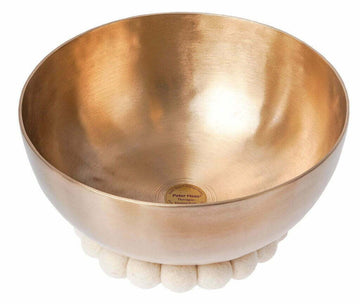
The most important facts in brief
- You will need a mallet or grater to strike or rub the Singing Bowl .
- Hold the bowl with the flat of your hand at strike or place it on a soft surface.
- The better the quality of the bowl, the more overtones you will hear and the longer the bowl will resonate.
- Reaming requires a little more practice than strike.
- Singing Bowls are often used as part of sound meditations and sound massages.
Preparation: How to create the right sound
If you want to find peace and relaxation at home with a Singing Bowl , the most important item you need is, of course, the Singing Bowl. There are many different types of singing bowls - it's best to find out which one is right for you before you buy. A single Singing Bowl is initially completely sufficient for personal use. In some cases, it can also be useful to use several Singing Bowls . This allows you to create different tones that complement each other in a harmonious way. You will need several different instruments, for example, if you want to address different chakras with the Singing Bowl .
Another important element for your sound meditation is the mallet (also known as a mallet). This is used to strike the Singing Bowl and make it vibrate. Find out more about the different types of mallet in our guide. The choice of mallet can have a significant influence on the sound of the bowl. If in doubt, try out different mallets to find a model that you like the sound of.
We recommend a soft and a hard felt mallet for beginners. The soft Hess Sound mallet is suitable for producing lower tones, which are good for the abdomen, among other things. The hard Hess Sound mallet produces higher tones that appeal to the heart and head area.
Instructions: How do I strike a Singing Bowl correctly?
To strike take the Singing Bowl on the flat of your hand and make sure that your palm and fingers are stretched out straight. It is important that the edge of the bowl can vibrate as freely and unhindered as possible. If you hold the Singing Bowl by the edge of the bowl, the vibration and therefore the sound will stop.
Alternatively, you can place the bowl on a singing bowl cushion or on a smooth, soft surface such as a carpet or blanket. This positioning minimally restricts the vibration of the bowl and allows the bowl to sound long and free.
Placement of the Singing Bowl
Your Singing Bowl can be placed here:
- on the flat of the hand
- on a singing bowl cushion
- on a carpet
- on a blanket
The mallet is held parallel to the edge of the bowl and struck briefly against it. Pull it back again as soon as you touch it. Make sure that you do not strike the rim from above or at an angle. The vibration unfolds through the shape of the bowl and produces a penetrating sound.
What you hear at the first strike is the fundamental frequency of your Singing Bowl. Depending on the bowl, overtones may also be audible. The more overtones and the more intense they are, the richer the sound spectrum of the bowl. The duration of the sound is also an important quality feature.
Instructions: How do I rub a Singing Bowl ?
Instead of hitting the Singing Bowl , you can also rub it. To do this, run a friction mallet along the edge in a circular motion to make the bowl vibrate. You don't need to exert much pressure. At some point, you will produce a singing sound that becomes stronger the longer you rub. Different mallets can be used to produce high and low fundamental tones.
This technique requires a little more practice and patience. With the right amount of speed and pressure, you can refine the sound.
To deepen the sound, strike the bowl once before rubbing.
Singing Bowls-Application for sound meditations
If your goal is to reduce stress and find peace with a Singing Bowl , you should try sound meditation. To do this, it is important that you have already familiarized yourself with your bowl and know how to place and strike it. This way, you no longer have to concentrate on handling it during the meditation.
Preparation of the pitch
When you feel confident using your bowl, prepare a place for the meditation. This can be in a room or outside. The Singing Bowl is usually placed on the floor for meditation. Make sure the surface is flat and soft. A mat is recommended on grass so that the vibration is not dampened by the stalks.
Ensure peace and quiet
Above all, it is important that the chosen location is quiet. Turn off your cell phone and other sources of noise. To sit comfortably, you can place a yoga mat or carpet on the floor. You should be able to reach Singing Bowl easily from your sitting position.
Initiate meditation
Now you can start meditating. This is similar to other forms of meditation, sitting with your back straight and eyes closed. Concentrate on your breathing. When you have calmed down inside, take your mallet and hit it gently against the Singing Bowl. Try to keep your eyes closed. Experience the intense sound and concentrate solely on the sound and the vibration. You can also hum the sound softly or imagine how the vibrations flow through your body.
Addressing specific areas of the body
Another option is to consciously concentrate on a specific region of your body and experience how the sound works there. Experiment a little yourself and find out what works for you. Many people find it easier to meditate with a Singing Bowl because the brain can concentrate on the sound and distracting thoughts stay away.
Caution: During pregnancy and in the case of acute physical or psychological complaints, please only use after consulting your doctor.
Singing Bowls-Application for sound massages
Another common use of Singing Bowls is in the context of sound massages. Here, specially developed Singing Bowls, the Peter Hess® Therapy Singing Bowls, are positioned specifically on the clothed body and gently sounded. This method requires a second person to perform the sound massage.
The special thing about sound massage is that both hearing and feeling are addressed in equal measure. While the harmonious sounds calm the mind, the fine vibrations emanating from the vibrating Singing Bowl gradually spread through the body. This allows deep relaxation to set in.

"A sound massage creates feelings of safety and security - an ideal prerequisite for regeneration and for promoting health, problem solving and learning."







